About Fluoropolymer (Teflon™)
Fluoropolymer is a general term used for plastic raw materials containing fluorine atoms.
There are 9 types, including PTFE (polytetrafluoroethylene) and PFA (perfluoroalkoxyalkane).
This is a plastic that combines heat resistance, slipperiness, non-adhesiveness, chemical resistance, low friction, and excellent insulation properties together.
Taking advantage of its characteristics, this is widely used in a variety of industries including food, chemical, semiconductor, liquid crystal, physics and chemistry equipment, transportation, and others, supporting modern industry.
In general, fluoropolymers are referred to as Teflon™, but Teflon™ is a product name for fluororesins manufactured by Chemours Corporation.
What is Teflon™?
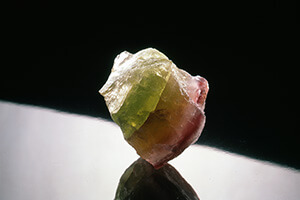
Teflon™ is the product name of the fluororesin PTFE raw material manufactured by Chemours Corporation.
Later, PTFE, called Teflon™, was discovered by Dr. Plunkett at DuPont Corporation in the United States in 1938.
In his new refrigerant research course, Dr. Plunkett stored ethylene tetrafluoride (TFE) gas in experimental pressure vessels. One day, when he opened the lid, the gas did not come out. When he investigated the container by cutting it open, he found a white powder had adhered to the inner wall. Soon, this white powder became known to be PTFE. The experiment notes from this time are still preserved at DuPont.
During World War II, this new discovery was used as a military product, but in 1945 DuPont trademarked PTFE as Teflon™ and began selling it for civilian use in 1946. This has made it possible to be used in many industries and it has supported the development of modern industry.
In 2015, Chemours Corporation split from DuPont Corporation, at which point, the Teflon™ trademark was transferred to Chemours Corporation.
In July 2017, we entered into a Teflon™ trademark licensing agreement with Chemours for fluoropolymer adhesive tape (Chukoh tape) after evaluating more than 50 years of manufacturing of fluoropolymer products.
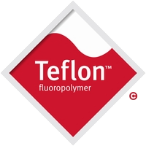
Teflon™ is a trademark of The Chemours Company FC, LLC used under license by Chukoh Chemical industries,LTD.
Types and Names of Fluororesin
There are nine varieties of fluororesins, including PTFE and PFA. The table below shows the abbreviations and names.
| Abbreviation | Name |
|---|---|
| PTFE | Polytetrafluoroethylene |
| PFA | Perfluoroalkoxyalkane |
| FEP | Perfluoroethylene propene copolymer |
| ETFE | Ethylene-tetrafluoroethylene copolymer |
| PVDF | Polyvinylidene fluoride |
| PCTFE | Polychlorotrifluoroethylene |
| ECTFE | Ethylene-chlorotrifluoroethylene copolymer |
| TFE/PDD | Tetrafluoroethylene-perfluorodioxole copolymer |
| PVF | Polyvinyl fluoride |
The most commonly used resin is PTFE. Many of the fluororesins commonly referred to as “Teflon™” refer to this PTFE.
Characteristics of Fluororesin
There are six main characteristics of fluororesin.
Heat-resistance, cold-resistance, non-adhesive, slipperiness, chemical-resistance, insulation, and weather-resistance.
Because it is rare for one plastic resin to have many characteristics, fluororesin is said to be “the last bastion of resin.”
■ Heat resistance (strength against heat)
The melting point of PTFE is 327˚C, which indicates better heat resistance than other plastics, and the continuous use temperature is 260˚C. Because it does not deteriorate even in high-temperature environments, it is required for parts used in the interior of vehicles and in the food production process.
* The heat-resistant temperature varies depending on the processed product. Confirm when using the product.
■ Cold Resistance (strength against cold)
PTFE has excellent cold resistance and withstand -253˚C, and maintains high-cold resistance that can be used even if it is processed into fluoropolymer products at -100˚C.
* Its cold-resistant temperature varies depending on the processed product. Confirm when using the product.
■ Non-stick property (Resistant to adhering)
Fluoropolymer has a property that makes it difficult for most substances to stick. It is also called releasability, and even if something sticks, it has the property of peeling immediately. Since it does not allow viscous substances to accumulate, it is used in mechanical parts such as food manufacturing processes and printing machines. This product also has the advantage of using non-adhesiveness to reduce the cleaning process.
■ Lowest friction
Fluoropolymer has the smallest coefficient of friction of any similar material. The coefficient of friction is low, so there is substantially no friction resistance. It is necessary where you want to prevent scratches caused in product conveyance and smoothly advance through a manufacturing process by sliding.
■ Chemical resistance (strong against chemicals)
Fluoropolymers are not impacted by most chemical solutions or solvents. It is difficult to cause impurities even when exposed to strong acids and strong alkali, so they are widely used in semiconductor manufacturing equipment. Fluoropolymer products are indispensable in semiconductor manufacturing equipment, including chemical containers, pipes, tubes, and wafer carriers.
■ Insulation (difficult for electricity to pass through)
Fluoropolymer has the highest level of electrical insulation among plastics. Dielectric constant and dielectric tangent are the smallest in fluoropolymers among plastics and they are not easily affected by frequency and temperature. As such, fluoropolymers are widely used in high-frequency applications and contribute greatly to a high-capacity high-speed communication society. In addition, substrates and wires made of fluoropolymer are combined with the heat and cold resistance properties of fluoropolymer. It is highly useful for maintenance-free products.
■ Weather resistance (strong against the outdoors)
Fluoropolymers are rarely affected by ultraviolet rays, visible light, or moisture. Although many plastics deteriorate over many years when placed in the open outdoors, fluoropolymers are less affected by the oxidation of oxygen and chemicals in the atmosphere, so they can continue to retain their strength without degradation for 30 years or longer. Because fluoropolymer is water repellent, it is mainly used as a roofing material, wall material, and sealing material in the construction field.
SKYTOP™ Suvarnabhumi International Airport (Thailand)
Characteristics of PTFE in light of its Molecular Structure
PTFE, a typical raw material for fluororesins, has a variety of properties derived from its molecular structure. The following is the molecular structure of polyethylene resin (PE) and fluororesin (PTFE).
| Composition formula | three-dimensional structure | |
|---|---|---|
| polyethylene(PE) | 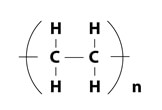 | 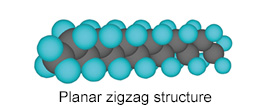 |
| fluororesin(PTFE) | 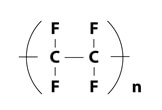 | 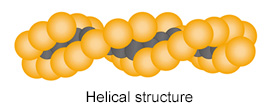 |
The molecular structure of PE is composed of carbon (C) and hydrogen atoms (H). PTFE is composed of carbon (C) and fluorine atoms (F). The bonding of C-C is the same, but it is different in the parts of carbon and hydrogen (C-H) and carbon and fluorine (C-F). When comparing C-H bonds and C-F bonds, C-F bonds have a higher binding energy, so breaking C-F bonds requires a lot of energy. The fact that it requires a lot of energy makes it so “difficult to degrade.”
Characteristic 1 Heat resistance/Weather resistance/Chemical resistance
As described above, the high coupling energy of carbon and fluorine (C-F) means that it is difficult to degrade unless a large amount of energy is applied. Furthermore, because the atoms of fluorine are larger than those of hydrogen, they are bonded in a slightly twisted state and have their own spiral structure. Because of this molecular structure, PTFE has the characteristics of heat resistance, flame resistance (oxidation resistance), weather resistance, and chemical resistance.
| Bond energy [kJ/mol] | Bond distance [nm] | |
|---|---|---|
| C-H bond(for CH4) | 412(CH4) | 0.110(CH4) |
| C-F bond (for CF4) | 484(CF4) | 0.138(CH3F) |
Characteristic 2 on-adhesive/water- and oil-repellent
For PTFE, the polarizability of the C-F bond (the ease of movement of the electrons when placed in the electric field) is small in the C-H bond. This is due to the strong interaction between the atomic shell of the fluorine atom and the electrons, which is very different from the case of other halogen atoms. Because the force acting between the “low polarization” molecules is small (small intermolecular forces), the free energy of the surface (surface tension) acts, making it harder for the material to stick. Because of this molecular structure, PTFE has non-adhesive, water- and oil-repellent properties.
| Types of Material | Angle of contact with water [degree] | Adhesion energy [dyn/cm] |
|---|---|---|
| PTFE | 114 | 43.1 |
| Silicone resin | 90 ~ 110 | 47.8 ~ 72.7 |
| PE | 88 | 75.2 |
Characteristic 3 Insulation
Because the C-F bond of PTFE has a large binding force and strongly constricts electrons in the molecule, PTFE has a high insulation resistance (volume resistance, surface resistance) and has characteristics that make it difficult for electricity to pass.
| Volume resistivity (Ω • cm) | Surface resistivity (Ω) | |
|---|---|---|
| Fluoropolymer (PTFE) | >1018 | >1016 |
| Fluoropolymer (PFA) | >1018 | >1016 |
Molding Method of PTFE
PTFE has a very high melting viscosity of 1010 to 12 Pa/sec, so it does not exhibit fluidity even when heated to the melting point of 327°C. (Does not melt into a puddle.) Therefore, ordinary molding methods such as the screw extrusion method and the injection molding method used for general-purpose plastics are not suitable. PTFE is broadly divided into three types, each of which is processed by a special molding method that is different from the normal molding method.
■ Molding powder
The molding powder is a powder that is generally less than 100 μm. It is often used for compression molding methods that compress and compact resin and then fire it. It is used to make PTFE lumps such as plates and integrated tanks. Furthermore, it is also possible to manufacture films by cutting a cylinder made by compressing the resin from the outside.
■ Fine powder
The fine powder is granular, but when pressure is applied, it becomes fibrous. For that reason, it is used in the paste extrusion molding method that mixes with solvent and then extrudes. Tubes and seal tapes are molded in this way.
■ Dispersion
Dispersion is an item that stabilizes the emulsion polymerized aqueous dispersion with a surfactant. Used in the impregnation coating method that immerses a cloth or the like in the dispersion. It is often fired after drying. It is used with SKYTOP™, a fabric product and architectural roofing membrane coated with PTFE impregnation coating on glass cloth.
| Types of Resin | Processing Methods | Applicable Products |
|---|---|---|
| Molding powder (powder shape derived from the suspension polymerization method) | Compression molding method/Ram extrusion method | |
| Fine powder (pellet shape derived from the emulsion polymerization method) | Paste Extrusion Method/Rolling Molding Method | |
| Dispersion (emulsion liquid derived from the emulsion polymerization method) | Impregnated Coating Method |
Molding Method of Fluororesin Other Than PTFE
Since the melting viscosity of fluororesins other than PTFE, such as PFA and ETFE, is about 103 to 4 Pa/sec, molding methods performed with general thermoplastic resins can be applied. However, since the fluororesin in the molten state corrodes metal that it touches, it is necessary to use a corrosion-resistant metal material. We also manufacture PFA tubes and PFA injection molded products.
[Reference]
・Japan Fluoropolymers Industry Association Fluororesin Handbook
・Fluororesin Q&A
